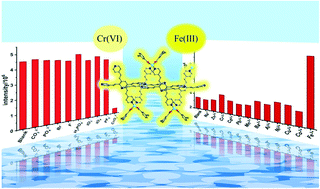Assembly of a Zn(ii) coordination polymer of tetrapyridyl tetraene ligands for selective sensing of CrO42− and Fe3+ in water via luminescence quenching and enhancement†
Abstract
Four Zn(II)-based coordination polymers (CPs), [Zn(4-tkpvb)(FB)2] (CP1), [Zn(4-tkpvb)(CB)2] (CP2), [Zn(4-tkpvb)(BB)2] (CP3) and [Zn(4-tkpvb)(NTP)]n (CP4), were prepared from solvothermal reactions of Zn(NO3)2·6H2O with 1,2,4,5-tetrakis((E)-2-(pyridin-4-yl)vinyl)benzene (4-tkpvb) in the presence of 3-fluorobenzoic acid (HFB), 3-chlorobenzoic acid (HCB), 3-bromobenzoic acid (HBB) and nitroterephthalic acid (H2NTP). These four compounds were structurally characterized by IR, elemental analysis, powder X-ray diffraction and single-crystal X-ray diffraction. CP1–CP3 have similar one-dimensional (1D) zigzag chain structures assembled by 4-tkpvb connecting the [ZnL2] (L = FB, CB, BB) units. CP4 displays an unusual 6-fold interpenetrating three-dimensional (3D) net with a ‘dia’ topology formed by linking the 2D [Zn(NTP)(4-tkpvb)]n layers via 4-tkpvb ligands. CP1–CP4 all exhibited luminescence emission in the solid state. The representative CP3 exhibited good water stability in the pH range from 3 to 13. It was revealed to be an intriguing luminescent probe for CrO42− anions in H2O by a selective fluorescence quenching method or Fe3+ ions in H2O by selective fluorescence enhancement. The detection limit was 0.679 ppm for CrO42− or 0.429 ppm for Fe3+. The emission quenching process may be ascribed to the overlap between the absorption band of the CrO42− anion and those of the excitation and/or emission bands of CP3, while the emission enhancement mechanism was likely due to the weak interaction between Fe3+ and the uncoordinated pyridyl group in CP3.



 Please wait while we load your content...
Please wait while we load your content...